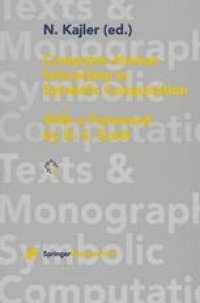
Ebook: Computer-Human Interaction in Symbolic Computation
- Tags: Math Applications in Computer Science, Computer Graphics, Symbolic and Algebraic Manipulation, Software Engineering, Combinatorics, Algorithms
- Series: Texts and Monographs in Symbolic Computation
- Year: 1998
- Publisher: Springer-Verlag Wien
- Edition: 1
- Language: English
- pdf
The well attended March 1994 HIse workshop in Amsterdam was a very lively con ference which stimulated much discussion and human-human interaction. As the editor of this volume points out, the Amsterdam meeting was just part of a year-long project that brought many people together from many parts of the world. The value of the effort was not only in generating new ideas, but in making people aware of work that has gone on on many fronts in using computers to make mathematics more understandable. The author was very glad he attended the workshop. * In thinking back over the conference and in reading the papers in this collection, the author feels there are perhaps four major conclusions to be drawn from the current state of work: 1. graphics is very important, but such features should be made as easy to use as possible; 2. symbolic mathematical computation is very powerful, but the user must be able to see "intermediate steps"; 3. system design has made much progress, but for semester-long coursework and book-length productions we need more tools to help composition and navigation; 4. monolithic systems are perhaps not the best direction for the future, as different users have different needs and may have to link together many kinds of tools. The editor of this volume and the authors of the papers presented here have also reached and documented similar conclusions.
There are many problems which current user interfaces either do not handle well or do not address at all. The contributions to this volume concentrate on three main areas: interactive books, computer-aided instruction, and visualization. They range from a description of a framework for authoring and browsing mathematical books and of a tool for the direct manipulation of equations and graphs to the presentation of new techniques, such as the use of chains of recurrences for expediting the visualization of mathematical functions. Students, researchers, and developers involved in the design and implementation of scientific software will be able to draw upon the presented research material here to create ever-more powerful and user-friendly applications.
There are many problems which current user interfaces either do not handle well or do not address at all. The contributions to this volume concentrate on three main areas: interactive books, computer-aided instruction, and visualization. They range from a description of a framework for authoring and browsing mathematical books and of a tool for the direct manipulation of equations and graphs to the presentation of new techniques, such as the use of chains of recurrences for expediting the visualization of mathematical functions. Students, researchers, and developers involved in the design and implementation of scientific software will be able to draw upon the presented research material here to create ever-more powerful and user-friendly applications.
Content:
Front Matter....Pages i-xi
Introduction....Pages 1-5
The ACELA project: aims and plans....Pages 7-23
Active structured documents as user interfaces....Pages 25-41
Direct manipulation in a mathematics user interface....Pages 43-60
Successful pedagogical applications of symbolic computation....Pages 61-88
Algorithm animation with Agat....Pages 89-115
Hypermedia learning environment for mathematical sciences....Pages 117-139
Chains of recurrences for functions of two variables and their application to surface plotting....Pages 141-161
Design principles of Mathpert: software to support education in algebra and calculus....Pages 163-177
Computation and images in combinatorics....Pages 179-208
Erratum to: Design principles of Mathpert: software to support education in algebra and calculus....Pages 209-209
Erratum to: Algorithm animation with Agat....Pages 209-209
Back Matter....Pages 209-216
There are many problems which current user interfaces either do not handle well or do not address at all. The contributions to this volume concentrate on three main areas: interactive books, computer-aided instruction, and visualization. They range from a description of a framework for authoring and browsing mathematical books and of a tool for the direct manipulation of equations and graphs to the presentation of new techniques, such as the use of chains of recurrences for expediting the visualization of mathematical functions. Students, researchers, and developers involved in the design and implementation of scientific software will be able to draw upon the presented research material here to create ever-more powerful and user-friendly applications.
Content:
Front Matter....Pages i-xi
Introduction....Pages 1-5
The ACELA project: aims and plans....Pages 7-23
Active structured documents as user interfaces....Pages 25-41
Direct manipulation in a mathematics user interface....Pages 43-60
Successful pedagogical applications of symbolic computation....Pages 61-88
Algorithm animation with Agat....Pages 89-115
Hypermedia learning environment for mathematical sciences....Pages 117-139
Chains of recurrences for functions of two variables and their application to surface plotting....Pages 141-161
Design principles of Mathpert: software to support education in algebra and calculus....Pages 163-177
Computation and images in combinatorics....Pages 179-208
Erratum to: Design principles of Mathpert: software to support education in algebra and calculus....Pages 209-209
Erratum to: Algorithm animation with Agat....Pages 209-209
Back Matter....Pages 209-216
....